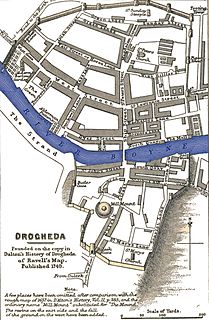 W
WThe siege of Charlemont took place in July – 14 August 1650 during the Cromwellian conquest of Ireland when the fortress of Charlemont in County Armagh Ireland was besieged by Charles Coote's Parliamentarian army, which was largely composed of soldiers of the New Model Army. The force led by Coote eventually took the fort from its Irish defenders, but not before they suffered heavy losses, with some 500 Parliamentarian Soldiers being killed during assaults on the formidable stronghold. In terms of the number of soldiers killed in battle, the siege of Charlemont was the second bloodiest engagement fought by the Parliamentarians in Ireland, only surpassed by the siege of Clonmel.
 W
WThe siege of Clonmel took place between 27 April and 18 May 1650, during the Cromwellian conquest of Ireland when the town of Clonmel in County Tipperary was besieged by Oliver Cromwell's New Model Army. Cromwell's 8,000 men eventually took the town from its 2,000 Irish defenders, but not before they suffered losses of around 2,000 soldiers. Most were killed after being caught in a trap by Hugh Dubh O'Neill on 17 May 1650.
 W
WThe Siege of Drogheda took place from 21 November 1641 to February 1642 during the Irish Rebellion of 1641. A Catholic force under Féilim Ó Néill laid siege to the town but failed to wrest the garrison from the Royalists. During the siege, the Irish rebels made three attempts to break into and capture the town. All three attempts failed and the town was ultimately relieved by English forces.
 W
WThe siege of Drogheda or the Drogheda massacre took place 3–11 September 1649, at the outset of the Cromwellian conquest of Ireland. The coastal town of Drogheda was held by the Irish Catholic Confederation and English Royalists under the command of Sir Arthur Aston when it was besieged by Parliamentarian forces under Oliver Cromwell. After Aston rejected an invitation to surrender, the town was stormed and much of the garrison was executed including an unknown but "significant number" of civilians. The outcome of the siege and the extent to which civilians were targeted is a significant topic of debate among historians.
 W
WThe Siege of Duncannon took place in 1645, during the Irish Confederate Wars. An Irish Catholic Confederate army under Thomas Preston besieged and successfully took the town of Duncannon in County Wexford from an English Parliamentarian garrison. The siege was the first conflict in Ireland in which mortars were utilized.
 W
WThe siege of Galway took place from August 1651 to 12 May 1652 during the Cromwellian conquest of Ireland. Galway was the last city held by Irish Catholic forces in Ireland and its fall signalled the end to most organised resistance to the Parliamentarian conquest of the country.
 W
WThe Siege of Kilkenny was the isolation and capture of the fortified capital of the Irish Confederates by the New Model Army of the English Parliamentarians in March 1650 during the conquest of Ireland by Oliver Cromwell.
 W
WThe city of Limerick has been besieged five times during the 17th century. Two of these sieges took place during the Eleven Years' War The first of these sieges occurred during the spring of 1642 when Irish Confederate troops besieged and took the town's citadel, King John's Castle from an English Protestant garrison.
 W
WLimerick, in western Ireland was the scene of two sieges during the Irish Confederate Wars. The second and largest of these took place during the Cromwellian conquest of Ireland in 1650–51. Limerick was one of the last fortified cities held by an alliance of Irish Irish Confederates and Royalists against the forces of the English Parliament. Its garrison, led by Hugh Dubh O'Neill, surrendered to Henry Ireton after a protracted and bitter siege. Over 2,000 soldiers of Cromwell's New Model Army were killed at Limerick, and Henry Ireton, Cromwell's son-in-law, died of plague.
 W
WThe city of Waterford in southeastern Ireland was besieged twice during 1649 and 1650 during the Cromwellian conquest of Ireland. The town was held by Irish Confederate Catholic under General Richard Farrell and English Royalist troops under general Thomas Preston. It was besieged by English Parliamentarians under Oliver Cromwell, Michael Jones and Henry Ireton.